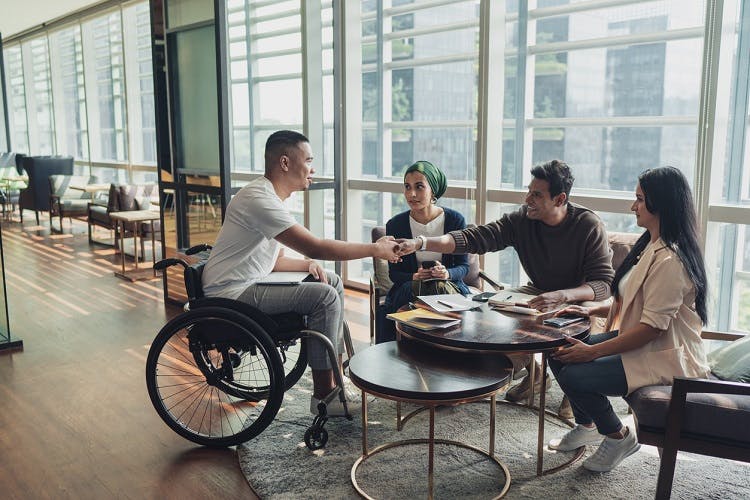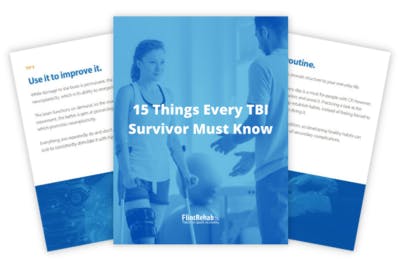No products in the cart.
No products in the cart.
No products in the cart.
No products in the cart.
Home » Neurological Recovery Blog » Traumatic Brain Injury » Returning to Work After Brain Injury: What to Expect & How to Prepare
Last updated on October 31, 2022

Returning to work after brain injury may require relearning skills necessary to meet job demands and acclimating to the work environment. While this can take time, with the proper support and preparation survivors can achieve their goal of returning to their occupation more swiftly.
There are also various employment rights and benefits provided to individuals with disabilities or special needs to help make their return to work after TBI a smoother process.
This article will discuss helpful tips for returning to work after brain injury and how to access employment benefits to ensure a smooth transition.
Please use the links below to jump directly to any section.
The return to employment after brain injury is a unique process for every survivor. The physical, cognitive, and behavioral secondary effects of TBI vary greatly. Depending on the type and severity of these effects, it may take survivors some time to learn how to manage them effectively to meet the demands of a specific job.
Some secondary effects of a TBI that can interfere with employment include:
While these effects can pose different challenges for returning to work after a TBI, they can often be managed with a combination of compensation tactics and restorative techniques.
For example, one secondary effect of TBI that may occur when the areas of the brain responsible for movement are affected is foot drop. This condition impairs the ability to lift the front portion of the foot, causing the toes to drag on the floor.
When a survivor with foot drop returns to work, they may have difficulties walking efficiently and safely around the workplace. Foot drop can also increase the risk of injury, especially in a fast-paced job that requires a person to walk excessively or climb stairs.
To help support the foot and ankle, therapists may suggest using a compensatory tactic like an AFO brace. However, while an AFO brace is helpful, it does not offer a permanent solution for foot drop. To address the root cause and improve the ability to lift the front of the foot, individuals must engage in restorative techniques and practice rehabilitation exercises.
Typically, an occupational therapist can provide individuals with the proper exercises and compensatory strategies to overcome the effects of TBI and maximize their independence to return to work and other daily activities.
To help ease the transition back to work after a TBI, it helps to strategize and prepare. Along with participating in therapy, occupational therapists may suggest practicing certain tasks at home first to help boost strength and confidence in the workplace.
To simulate working at home, individuals can:
Practicing these tasks at home can help individuals prepare physically and mentally for the workload ahead. Since every job has different demands, try to find activities at home that best simulate tasks specific to one’s desired job. Simulating work at home can also help individuals cope with feelings of stress or anxiety that may arise in the workplace after a TBI.
There are various resources available that focus on helping TBI survivors adapt in the workplace. Understanding what adjustments employers can make before returning to work after brain injury may help individuals feel more at ease and be better prepared.
For example, the Americans with Disabilities Act (ADA) prohibits employers from discriminating against individuals with disabilities. Under the ADA, employers are required to provide reasonable accommodations to all employees with disabilities. Although this law applies to companies with 15 employees or more, some states may have additional laws that apply to companies with fewer than 15 employees.
Some accommodations individuals can discuss with their employer include:
Employers can also provide physical and technological aids, such as modified desks or chairs, wheelchair accessibility, and computer programs to help survivors acclimate to the workplace and stay on task. By providing proper accommodations, employers can help individuals improve their overall performance, which is beneficial for both the employer and the survivor.
A vocational rehab specialist or an occupational therapist can help determine which adaptations are needed and will benefit an individual the most. They can also provide more guidance and tips on how to access employment rights, disability, and social security benefits.
Lack of employment due to brain injury can cause financial difficulty, which can increase feelings of stress and anxiety. Fortunately, many programs provide survivors with a source of income while they work toward recovery and find employment.
Individuals can receive these benefits either through Disability Insurance (SSDI) or Supplemental Security Income (SSI). It’s important for TBI survivors to apply for these benefits as soon as possible because it can take several weeks or months to process the claims and receive benefits.
According to the Social Security Administration (SSA), TBI survivors may qualify for benefits if they experience either:
Benefits typically don’t begin until 6 months after injury, and they usually cease once the individual finds employment. However, there may be other programs that make exceptions and continue to help survivors who are employed.
Additionally, individuals receiving Disability or Supplemental Security Income may be eligible for the Ticket to Work program. This program (available in all 50 states) provides TBI survivors with access to career counseling, vocational rehab, job placement, and training.
Other Social Security incentives from the Ticket to Work program may include:
Accessing disability and social security benefits after brain injury can help provide a sense of comfort and ease during recovery. Returning to work shortly after a brain injury can be counterproductive and interfere with recovery. Therefore, it’s important to take the time to heal and prepare to return to work with the appropriate resources.
Returning to work after brain injury is a unique process for every survivor. While it can take time and patience, with the proper resources and preparation individuals can have a smoother transition back to work.
We hope this article helped guide you through the process of returning to work after brain injury and encouraged you to reach your goals.

If you like our content, you’ll love our ebook and newsletters! Get instant access to our TBI recovery tips ebook with 20 pages of helpful advice by signing up below.
You’ll also receive our emails that share survivor stories and more useful TBI recovery tips, which you can opt out of at any time. (We know you’ll love them, too.)
We will never sell your email address, and we never spam. That we promise.


Time with a speech therapist is extremely valuable during recovery, especially if you struggle with communication, critical thinking, or memory after brain injury. Insurance typically covers speech therapy for a fixed amount of time. But once it’s over, recovery is in your hands.
That’s why a team of neuroscientists and clinicians from Boston University created the CT Speech & Cognitive Therapy app. Designed for those recovering from stroke, TBI, or living with neurological conditions, the app contains over 100,000 cognitive exercises that are all available right from your phone or tablet. That’s like having a speech therapist by your side whenever you want!
This app is the perfect fit if you want to improve your speaking, memory, or general mental sharpness. And, it’s affordable at just $29.99/month!
“For the past 6 months, my son has used the app about three times a week. The app is like a virtual therapist, it’s very easy to use, and it gives him immediate feedback.
He now understands things faster, can make decisions with less hesitation, has improved recognition of words, and his confidence is higher. I also find it easy to get in touch with customer service; they pleasantly help out. The whole experience has been great.”
— Miriam
With the CT App, you can get the guidance you need right from your phone or tablet. You can use it on your own or in between sessions with your speech therapist.
Whether you struggle with aphasia, memory loss, or critical thinking, the CT Speech & Cognitive Therapy App can help.
“The CT app has helped me gather my confidence by building on and reinforcing old forgotten skills. It helps to see my percentages increase, and work harder when they decrease. It’s very self-motivating.” -Kathryn
We are confident that this app will help improve your speech and cognitive function after brain injury. Like our recovery tools, the CT App is also covered by our 30-day money-back guarantee.

Do you know these 15 TBI recovery tips?
Get a free copy of our ebook 15 Things Every TBI Survivor Must Know. Click here to get instant access.
Grab a free rehab exercise ebook!
Sign up to receive a free PDF ebook with recovery exercises for stroke, traumatic brain injury, or spinal cord injury below: